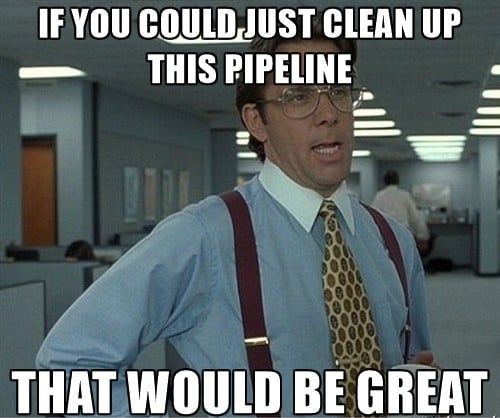Vertriebspipelines 101
Die Grundlagen, um Ihren B2B-Verkaufsprozess zu rocken.

Lange Tage, lange Nächte. Ein voller Kalender, ein heißes Telefon und ein überfüllter Posteingang. Kaffee ist Ihr bester Freund und das Geschäft läuft nonstop. Klingt wie das Leben eines erfolgreichen Unternehmers, oder? Und doch, inmitten dieses Berges von Papieren, Haftnotizen und E-Mails spüren Sie ein Jucken. Es werden zwar Verkäufe getätigt, aber sie fühlen sich eher wie ein Unfall als wie ein Erfolg an. This isn’t working.
I used to just let my thoughts and ideas float, not bothering with structure and organisation. To-do lists and diaries were for suckers. As a student that meant missing chapters to study. As an entrepreneur it means missing deals and revenues. And while nobody likes bad grades, missing out on sales is worse. It’s dangerous for the survival of your business. Especially if you’re in the early stages.
What you need is a system. Something to bring order to the chaos that is your sales process. Something to keep track of your leads, so no deals fall through the cracks anymore. What you need, my friend, is a sales pipeline. We’ll show you why you need one, how to set up one up and what you can do to have it run as smoothly as possible.
Why do I need this, exactly? 🤔
If you want to excel at something, you first need to get the basics right. The basics of b2b selling are pretty straightforward. Someone is looking to improve his/her life and you’re trying to help them see why your product or service is the best one for the job. Das ist ganz einfach.
But humans are complicated creatures. Decision-making is not a linear process and external factors — like competitors — may come into play. As a sales person it’s your job to guide your prospect through the complexities that come with decision-making, straight to your solution.
A sales pipeline is a snapshot of where leads are in your sales process. It’s a visual, organised way to keep track of your potential buyers as they move through the different stages. Thinking of your sales process as a pipeline forces you to streamline your efforts into a repeatable and measurable process with clearly defined steps. It creates a shared understanding that will make your sales more actionable and scaleable.

The goal is to take your sales lead from stage to stage, all the way up to the definitive yes. If you fail, the deal is lost or can be put in the fridge to retarget later. The thing is that in sales you can’t control results. What you can control, are activities. Only when your whole team has a shared understanding of what your sales process should be, you’ll be able to optimise those activities and, in turn, improve results. In order to improve, you first need to know what your problems are.
Where is it that most deals go bad? What stage is taking the longest? How about stage-over-stage conversion? How many deals do I need to add to my pipeline to reach my goals? The sales pipeline will help you find out where you fail. Next, you’ll be able to turn those failures into best practices.
One step at a time ☝️
Chances are you’re already using the sales pipeline metaphor in approaching potential buyers. The typical stages of a sales pipeline follow the natural flow of a sales process. Of course, no sales pipeline outline fits all. Some stages may be more relevant to your sales process, others will overlap. The selling stages of your SaaS company will be different from those of a realtor. However, conceptually, a sales process goes something like this:
- Blei
The first time someone appears on your radar. He or she may be interested in your solution and you suspect they might be a good fit. Leads may just come to you, for example because they filled out a form on your website. Or you look for them, in places like conferences, social media or just ‘the Internet’. This is actually a vor der Pipeline Phase. Sie müssen zunächst herausfinden, ob er ein echter Interessent für Ihr Unternehmen sein kann, bevor er zu einer Verkaufschance wird. - Kontaktiert
The first time you reach out and have actual contact. This will likely happen by email or call. Your goal is to verify the lead’s interest in your solution. If yes, you put them in the pipeline. If you find a lead from a positive reaction to a cold email or call, you can immediately put the lead in this stage. - Qualifizierung
This is where you determine whether the lead is a good fit for your business as a customer. Are they within your target market? Do they have a real need for your solution? Do they have a budget and a clear timeline to buy in? Are you talking to the right people in the company? You’ll have to determine if you think a deal can be closed within the usual length of your sales process or not. This often involves a meeting and/or a series of calls. You’ll look for a match between your solution and your lead’s specific challenges. Don’t lose any time if there’s no match: just close the sales opportunity as lost. - Vorschlag gemacht
By now, you’ve built enough momentum to make a formal offer. It’s now up to the lead to either buy or refuse. - Gewinnen/Verlieren
The moment of truth. Time to get a signature on that bottom line… or not.
A sales pipeline is like an arcade game. As a player you have to get your lead from stage to stage. You only win if you can complete all 5 stages. One mistake on the way and it’s game over for that lead. This is why it’s key to have a proper amount of leads in the front of your pipeline. You’ll want to protect yourself from certain leakage in your pipeline and make sure you win enough deals at the end of the day. This quality of the sales pipeline to actively drive your sales process is one its most important reasons for you to use it.
Great! Where do I start? 🤠
Nehmen Sie ein Blatt Papier oder einen Stapel Post-its und eine Tafel. Schreiben Sie Ihre Phasen von links nach rechts auf und ordnen Sie jeden Ihrer aktuellen Leads einer Phase zu. Sie können auch andere Daten hinzufügen: Größe des Geschäfts, voraussichtlicher Abschlusstermin und der Vertriebsmitarbeiter, der das Geschäft bearbeitet. Passen Sie dann die Daten an, wenn Sie Ihre Pipeline mit der Zeit und den Leads durchlaufen. Verfolgen Sie die Konvertierung von Phase zu Phase und die durchschnittlich benötigte Zeit pro Phase.
Um Bäume und Zeit zu sparen, sollten Sie den Stift und das Papier gegen eine gute alte Tabellenkalkulation eintauschen. Dies kann eine gute Möglichkeit sein, sich mit den Grundlagen der Verwaltung von Verkaufspipelines vertraut zu machen. Wir haben eine Vorlage zusammengestellt, die Ihnen den Einstieg erleichtern soll. Sie deckt alle Grundlagen des Sales Pipeline Management ab. Lassen Sie sich überraschen!
Tools like Excel or Google Sheets can work fine for you as long as you’re not dealing with, let’s say, more than 10 potential customers at a time. But, as you grow bigger, the risk of losing overview and deals will do too. This is where you may want to consider using a proper CRM. Salesflare was developed to be simpler than pen and paper and more powerful than a spreadsheet.
Let’s get you a head-start 👊
So now you know what a sales pipeline is and why you need one. Time for you to get behind the wheel and start racing. Here’s three tips to make sure you make it off the start grid in pole position.
Crunch the numbers 📈
You don’t want to be driving in the dark. It’s dangerous and you have no idea where you will end up. Your pipeline’s conversion metrics are essential to keep you on the right track and will make your sales efforts scaleable.
Zunächst einmal der Verkaufszyklus. Ihr Verkaufszyklus ist die Zeit, die ein potenzieller Käufer braucht, um ein Kunde zu werden. Anders ausgedrückt: Wie lange dauert es in der Regel, bis ein Interessent in Ihre Pipeline gelangt und am anderen Ende wieder herauskommt? Wenn ein potenzieller Kunde länger braucht als üblich, sollten Sie ihn ausschließen und sich auf andere Interessenten konzentrieren. Das gleiche Prinzip lässt sich auch auf die einzelnen Phasen anwenden.

Second, stage-over-stage conversion. Knowing how many deals you close on average will give you an idea of how many leads you need to add to meet your objectives. As said before: you can’t control results, but you can control activities.
Verkauf ist ein Zahlenspiel. Fakten, Zahlen und Wissenschaft sind das, was Sie brauchen, um Ihren Verkaufsprozess im Griff zu behalten. Nur wenn alle Vertriebsmitarbeiter dieselbe Definition befolgen, können Sie der Pipeline vertrauen.
Flush regularly 🌊
Bigger isn’t always better. A pipeline stuffed with leads may seem like a good thing, but as a startup or small business you don’t have infinite resources. You’ll want to be selective in what you spend your time and energy on.

Das Aussortieren von Leads wird sich kontraintuitiv, ja sogar seltsam anfühlen. Aber es ist notwendig, um einen stetigen Fluss von Leads und Geld durch Ihre Vertriebskette zu gewährleisten. Ein paar Dinge können Sie tun, um Ihre Leitungen blitzsauber zu halten:
- Be picky when it comes to lead qualification. A clean pipeline begins with the quality of the leads you put in in the first place. If you don’t really believe a lead could turn into a sale, it doesn’t belong in your pipeline. You want to focus your efforts on deals you feel confident of closing within a healthy sales cycle.
- Do spring cleaning every one or two weeks. Check up on all the deals in your pipeline and identify the ones that hold up the pack. You don’t have to get rid of them. Instead, put them in an alternative pipeline or in the fridge, to follow up on later.
- Focus on deals you’re confident of closing within a healthy sales cycle. If you’re a Salesflare user you can use the hot-or-not feature to detect hot leads. Sluggish ones will show up in your insights and home screen.
The Power of Automation 🤖
Ihre Vertriebspipeline braucht einen Fluss und Sie auch. Verwenden Sie die Macht der Gewohnheit um Ihre Pipeline im Griff zu behalten. Das Einstellen neuer Geschäfte, die stufenweise Qualifizierung von Leads und die regelmäßige Reinigung der Pipeline sind wichtige Aktivitäten, die Sie leicht in eine tägliche Routine einbauen können. Wenn Sie diese Aktivitäten zur Gewohnheit machen, gewährleisten Sie maximale Produktivität bei minimaler Konzentration. Ihre Pipeline auf Autopilot.

And you don’t have to stop there. Today’s technology makes it possible to run most other, mindless tasks automatically. No more admin work. Read here how Salesflare frees you of manually inputting data and automatically logs customer interactions. Zapier can make your CRM work together with all of your other productivity tools, like Google Sheets, MailChimp, Trello and Slack. You can just focus on the art of managing human relationships and closing sales while your pipeline runs itself.
Eine Studie der Harvard Business Review aus dem Jahr 2015 hat einen direkten Zusammenhang zwischen einem effektiven Vertriebspipeline-Management und einem starken Umsatzwachstum festgestellt. Die Verwendung einer Vertriebspipeline zur Verwaltung Ihres Vertriebsprozesses ist der schnellste Weg, um Prognosen zu erstellen, Quoten zu erfüllen und zu sehen, dass Ihre Vertriebsmitarbeiter mehr leisten, als Sie für möglich gehalten haben. Es gibt keinen Haken, Sie müssen es nur einrichten. Sie können noch heute damit beginnen.
Schauen Sie sich diesen neueren, längeren und detaillierteren Leitfaden über Vertriebskanäle an, wenn Sie mehr erfahren möchten.
Wir hoffen, dass Ihnen dieser Beitrag gefallen hat. Wenn ja, drücken Sie ❤ und verbreiten Sie die Nachricht! Du kannst uns folgen @salesflare auf Twitter für weitere heiße Themen zu CrM, Vertrieb, Growth Hacking und Startups.
- Die 20 besten Verkaufsbücher, die Elon Musk wahrscheinlich liest - 14. Februar 2023
- 6 narrensichere Wege, wie Ihr Startup seine ersten 100 Kunden bekommt - 6. Dezember 2022
- Wie man einen Verkaufstrichter aufbaut, der verkauft - 2. September 2021
